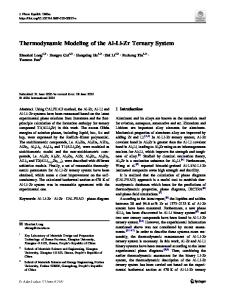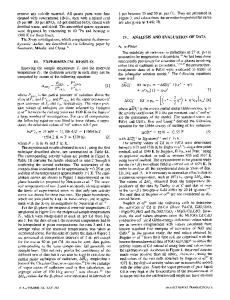Thermodynamic investigations of the ternary Au-Sn-Zn system
- PDF / 410,045 Bytes
- 8 Pages / 612 x 792 pts (letter) Page_size
- 24 Downloads / 369 Views
I.
INTRODUCTION
THERMODYNAMIC investigations of the liquid ternary Au-Sn-Zn system are performed for several reasons. One reason to investigate these alloys is their possible application for solder materials. Due to health concerns and environmental reasons, lead will be replaced in the near future in all solder materials. New lead-free solders must be developed, and for certain applications, the Au-Sn-Zn system could be a candidate. Currently, many different physical properties (melting behavior, surface tension, and electrical conductivity) and mechanical properties of these new materials are measured, but very little research is done to determine the thermodynamic properties. The other reason is the tendency for chemical short range order (CSRO) which can be found in many binary and ternary liquid alloys. For binary alloys, a critical evaluation is given by Komarek.[1] In the liquid Au-Zn system, calorimetric measurements by Hayer[2] and electromotive force (emf) investigations by Sacchetto et al.,[3] Yazawa and Gubcova,[4] Gerling and Predel,[5] and Prasad et al.[6] show a strong negative enthalpy of formation. In all investigations, a linear temperature dependence of the emf was found. Hultgren et al.[7] report a dent in the integral entropy curve at approximately 50 at. pct Zn. Gerling and Predel[8] used the association model to calculate the thermodynamic functions and compared the calculations with their experimental results. To get the best fit, they had to assume associates of the composition Au:Zn 5 1:1 in the melt. Prasad and Singh[9] got similar results when they applied the quasi-lattice model to this system. In the liquid Au-Sn system, emf measurements by various authors[10–14] show a nonlinear temperature dependence near the 1:1 composition, and from calorimetrie investigations, Hayer et al.[15] reported a temperature dependence of the enthalpy of mixing, DH. In Sn-Zn, the third binary system, Kleppa,[16] Ptak,[17] and Scheil et al.[18,19] report some indication of a temperaturedependent DH. Some of these effects are attributed to the S. KARLHUBER, Research Scientist, and A. MIKULA, Professor, are with the Institute of Inorganic Chemistry, University of Vienna, A-1090 Vienna, Austria. F. SOMMER, Professor, is with the Max-Planck-Institut fu¨r Metallforschung, Institut fu¨r Werkstoffwissenschaft, D-70174 Stuttgart, Germany. Manuscript submitted March 19, 1996. METALLURGICAL AND MATERIALS TRANSACTIONS B
existence of CSRO, which can be described by assuming association in the melt.[1] It seemed therefore of interest to investigate the thermodynamic properties of the liquid ternary Au-Sn-Zn alloys. In the present investigation, we started from the Au-Sn binary system and added zinc. By means of a galvanic cell, the emf was measured, and the partial Gibbs energy and the partial enthalpy and entropy of zinc of 42 ternary alloys were determined as a function of temperature and concentration. The measurements were carried out at four cross sections with a constant Au:Sn ratio of 9:1, 3:1, 1:1, and 1:3, res
Data Loading...











